May skies offer a total eclipse of the moon and more
May 4, 2022, 2:00 PM

(Unsplash Photo)
(Unsplash Photo)
May is here and the skies will offer some amazing sites for you and yours!
The fifth month is a time in Arizona where the weather will begin to transition to a more summerlike feel, as the night will produce some mild and clear skies.
This is a most amazing month as we will see the first of two total lunar eclipses and some wonderful planetary alignments too.
With the sun setting well after 7 p.m. for most of Arizona and the nation, we begin our celestial journey with an analysis of the moon and its position in our skies.
As May opens up, the moon begins as a thin crescent low in the west-northwest sky after sunset.
Some of the most amazing views of the moon, occur when we can observe the thin sunlight region and spy on the ghostlike glow known as earthshine.
Earthshine is the light of a bright Earth shining on the lunar surface and the moon reflecting that feeble light back to us.
A full moon is minus 12 on the magnitude scale, but the full Earth shining on the moon has a maximum magnitude of minus 17.7 on this scale. The sun is a blazing minus 26 on the magnitude scale.
The moon then reaches its first quarter phase on May 8. From then on, the moon will be in a gibbous phase (egg-shaped) till its reaches the full flower moon on May 15 at 9:14 p.m. Arizona time.
This is the night of the first of two total lunar eclipses. We will cover all the fine details in the next few updates.
Here is a basic tutorial on the great total lunar eclipse of May 15-16.
A total lunar eclipse is safe to view from start to finish and you do not require any special eye protection.
Here is what it should look like at best.
The moon will then wane and reach last quarter on May 22. The moon continues on its march towards the eastern sky as it reaches a new phase May 30 – really dark skies!
Most of the planets will lie in the morning sky, with the exception of Mercury. The innermost planet will remain the west-northwest sky just after sunset. The moon and Mercury passed each other May 2 by less than 2 degrees.
Recently, Mercury has been identified as a planet that has a sodium tail in space, all this due to the solar wind pounding the surface of the planet and sending ions of sodium away from the planet.
Here is what that looks like.
Venus, Jupiter, Mars and Saturn remain in the predawn sky in the east. The moon and Venus will make for a great sight on the morning of May 26 as they pass within 0.2 degrees apart.
All this is followed up by a close planetary conjunction with Mars and Jupiter, as they pass within 0.6 degrees on the morning of the 26th in the east before dawn.
For those of you with dark and moonless skies, look for the annual Eta Aquariid meteor shower. Look to the east-southeast a few hours before dawn, on May 5-6. You may get to see at least 10 to 20 meteors per hour. All these are from Halley’s Comet.
The details are here.
We will cover the May 15 total lunar eclipse in great detail in future columns.
To print your own monthly star chart, click here.
To view satellites/dates/times of passage, click here.
Listen to the Dr. Sky Show on KTAR News 92.3 FM every Saturday at 3 a.m.
Podcasts are available here.








